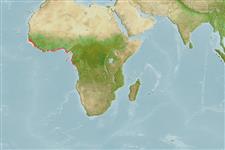Environment: milieu / climate zone / depth range / distribution range
Ecology
Marine; freshwater; brackish; pelagic-neritic; depth range 0 - 35 m (Ref. 86940). Tropical; 17°N - 7°S, 17°W - 14°E (Ref. 54448)
Africa: Atlantic coasts from northern parts of Senegal south to Baie de Saint-Bras in Angola (Ref. 188, 3509), also in lagoons and river estuaries (Ref. 188, 81270).
Length at first maturity / Size / Weight / Age
Maturity: Lm 13.0, range 13 - 18 cm
Max length : 30.0 cm SL male/unsexed; (Ref. 27000); common length : 16.0 cm SL male/unsexed; (Ref. 188); max. published weight: 144.00 g (Ref. 86940)
Dorsal spines (total): 0; Dorsal soft rays (total): 14 - 17; Anal spines: 0; Anal soft rays: 45 - 50; Vertebrae: 42 - 43. Diagnosis: Body moderately deep, compressed, belly with a sharp and serrated keel of scutes from gill opening to anus, 25-27 pre-pelvic and 6-8 post-pelvic sharp scutes (Ref. 187, 188, 81270). Eye large, mouth pointing upwards, lower jaw projecting (Ref. 187, 188). Dorsal fin at or before midpoint of body; anal fin long, with more than 40 finrays, its origin below dorsal fin base; pelvic fins small (Ref. 187, 188). Swimbladder with two short tubes passing back in the muscles on either side of haemal spines (Ref. 188). Other clupeoid fishes in the area are more slender, have a much shorter anal fin and the lower jaw is not strongly projecting (Ref. 188).
Found in the marine environment, pelagic, along beaches and just off shore, down to about 25 m, also in lagoons and estuaries, penetrating into almost freshwater (Ref. 187, 188, 54448). A marine migrant (Ref. 117399). Rarely found below 35 m depth (Ref. 86940). It feeds on small planktonic animals, e.g. small fish and crustaceans; it doesn't seem to feed on plankton (Ref. 188, 3166, 47405).
Whitehead, P.J.P., 1985. FAO Species Catalogue. Vol. 7. Clupeoid fishes of the world (suborder Clupeoidei). An annotated and illustrated catalogue of the herrings, sardines, pilchards, sprats, shads, anchovies and wolf-herrings. FAO Fish. Synop. 125(7/1):1-303. Rome: FAO. (Ref. 188)
IUCN Red List Status (Ref. 130435: Version 2024-1)
Threat to humans
Harmless
Human uses
Fisheries: commercial
Tools
Special reports
Download XML
Internet sources
Estimates based on models
Preferred temperature (Ref.
123201): 25.9 - 28, mean 27.5 °C (based on 160 cells).
Phylogenetic diversity index (Ref.
82804): PD
50 = 0.5000 [Uniqueness, from 0.5 = low to 2.0 = high].
Bayesian length-weight: a=0.00676 (0.00557 - 0.00821), b=3.02 (2.97 - 3.07), in cm total length, based on LWR estimates for this species (Ref.
93245).
Trophic level (Ref.
69278): 3.6 ±0.2 se; based on diet studies.
Resilience (Ref.
120179): High, minimum population doubling time less than 15 months (K=0.8-1.3).
Prior r = 1.19, 95% CL = 0.79 - 1.79, Based on 3 data-limited stock assessments.
Fishing Vulnerability (Ref.
59153): Low vulnerability (21 of 100).
Climate Vulnerability (Ref.
125649): High to very high vulnerability (73 of 100).
Nutrients (Ref.
124155): Calcium = 206 [110, 411] mg/100g; Iron = 2.01 [1.19, 3.28] mg/100g; Protein = 19.4 [18.0, 20.7] %; Omega3 = 0.397 [0.206, 0.739] g/100g; Selenium = 44.4 [20.6, 85.5] μg/100g; VitaminA = 20.2 [8.0, 49.5] μg/100g; Zinc = 1.52 [1.07, 2.15] mg/100g (wet weight);
